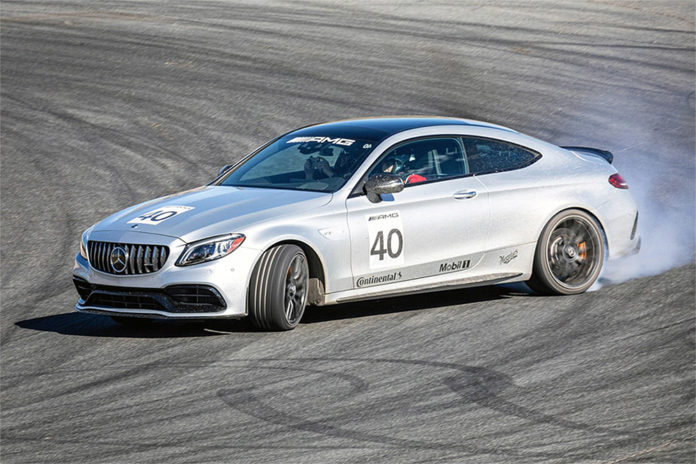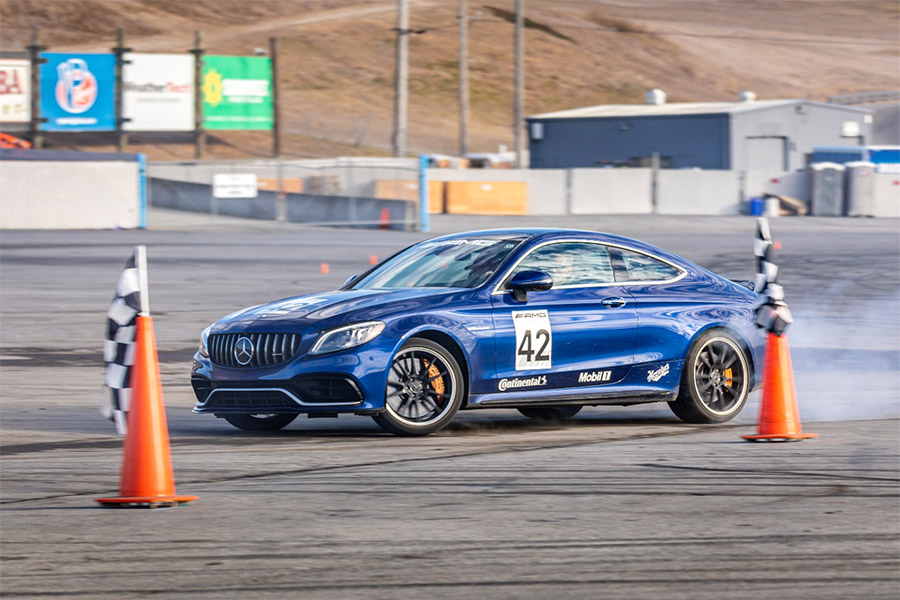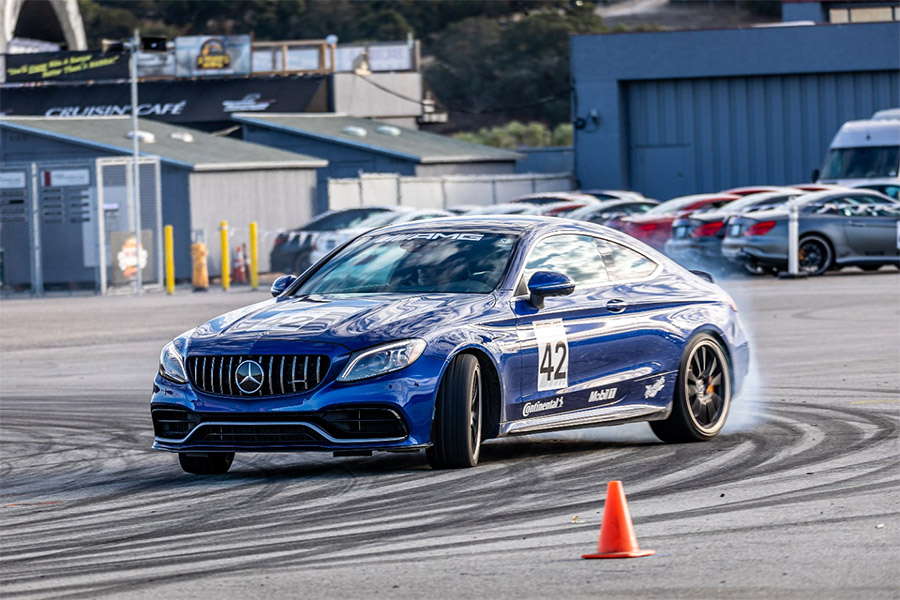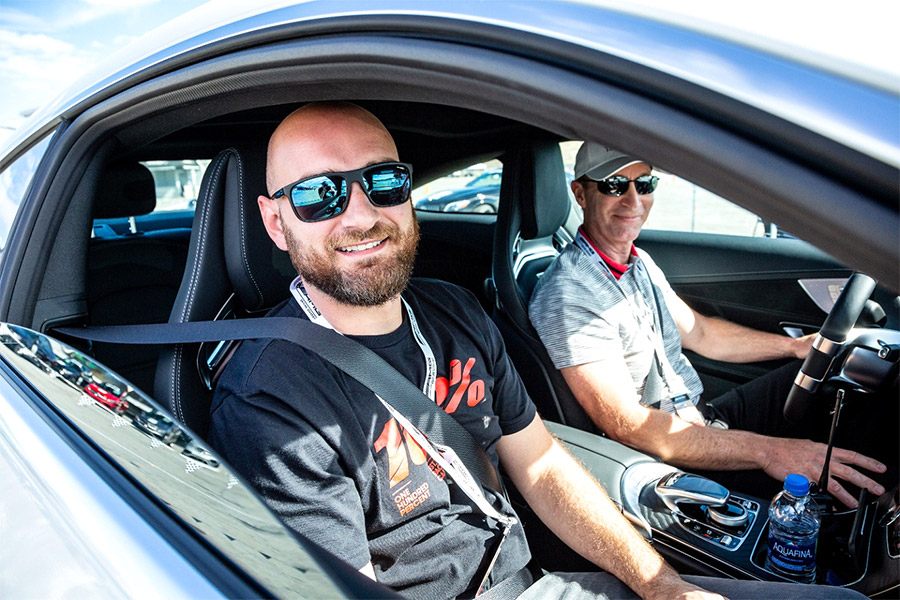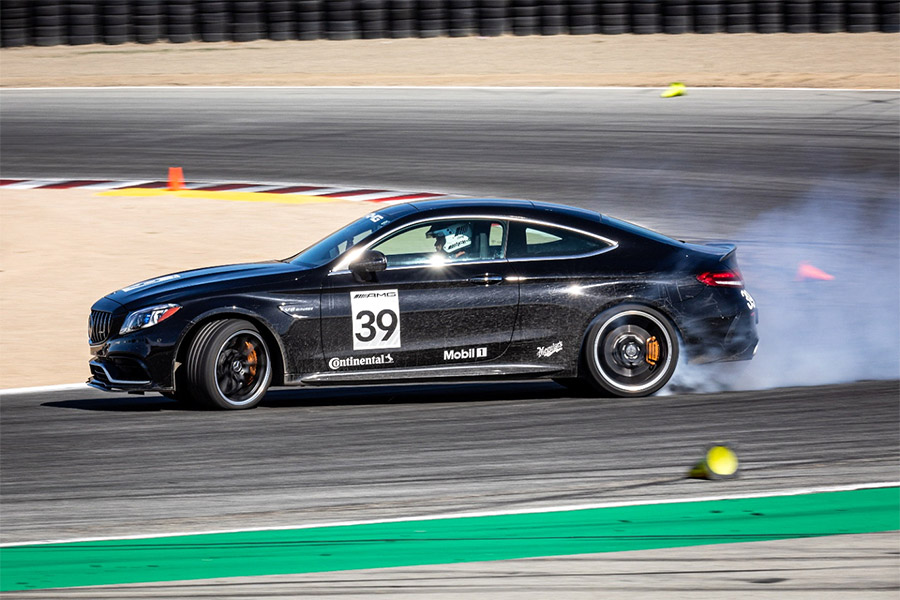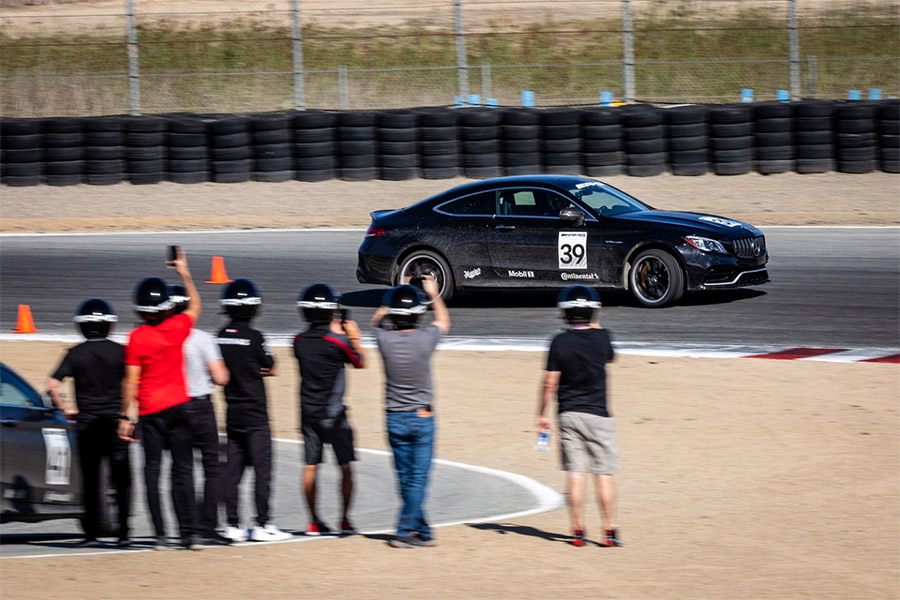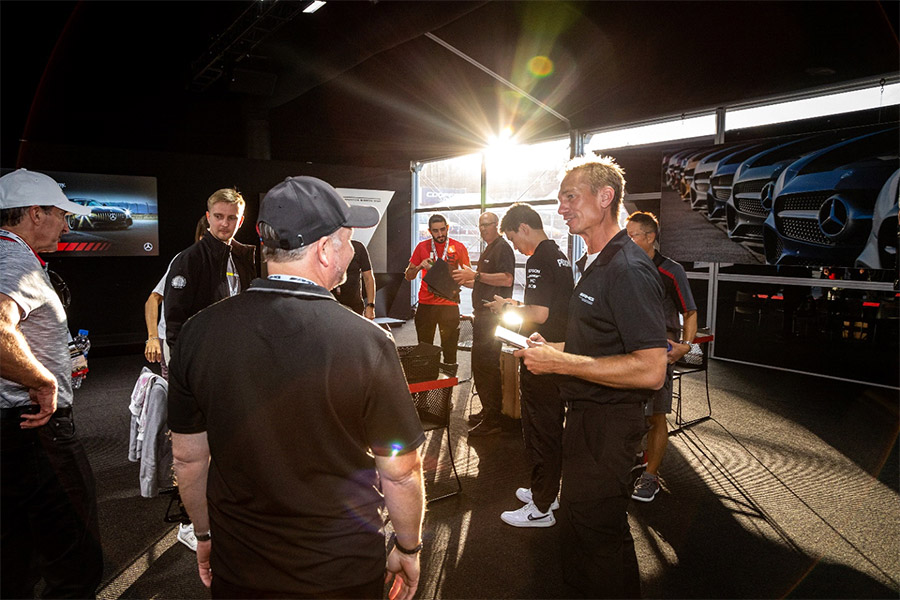Drifting is a simple matter of physics. Friction is the magic ingredient to make a car accelerate, brake and hold the road during cornering. The four tires beneath a car, however, only have a finite amount of grip. The tiny contact patches for each tire will fight but ultimately give way when pushed beyond their limits.
The skill of drifting uses steering and throttle inputs to control how a car breaks traction and slides through a corner. Get it right and the effect is spectacular and great fun. Get it wrong and the car either fails to slide or slides too much and spins without making the corner exit.
Car control on the limit is easier described than performed in practice. To do it well, a necessary component is a car capable of overcoming the best efforts of the tires to maintain friction. Fortunately, Mercedes-Benz and the AMG Driving Academy run a drifting school with instructors, rear-wheel drive AMG powered cars, and an endless supply of Continental tires.
Speed Journal resident driver Jeff Francis had the opportunity to spend a day at the AMG Academy a few months ago getting an introduction to drifting. Read more about that experience here. While learning the fundamentals of car control, Francis also had a blast rocketing sideway around the Laguna Seca Raceway paddock. With an opportunity to return and build on the fundamentals of drifting at the AMG Academy, Francis readily returned to Laguna Seca Raceway for a program called Drift+.
Francis joined nine other students on a crisp morning who quickly found friends and familiar instructors from their prior visits to the AMG Driving Academy. A prerequisite to the Drift+ training is that students have to successfully complete the AMG Driving Academy Drift program. The group quickly formed a comfortable bond over an excellent breakfast and the camaraderie continued to build through the day. That atmosphere made the day even more enjoyable while learning the technical aspects of driving and drifting.
The instructors started the program with a cycle of stretching to get the students’ limbs and joints prepared for the action. The group moved to a batch of C63 S coupes, establishing correct seating position, proper bend in the knees and arms, and hand over hand steering wheel technique. Instructors emphasized good lines of vision, particularly as sliding sideways would mean that looking forward might require looking through the side windows rather than ahead through the windshield.
It was time to get driving. Each car had a two-way radio for instructor communication and pairs of students split up to share cars. The first exercise was to initiate a slide around a simple horseshoe shape, defined by cones laid out in the paddock, and lightly sprayed with water to help facilitate sliding. The wrinkle, however, was learning how different settings impacted the car’s behavior. Students were free to experiment with settings for the suspension and manual or automatic transmission shifting, but the most crucial setting was the dial for traction control.
The C63 S was equipped with nine different traction control settings ranging from more electronic intervention to less. The car’s electronic tools are designed to limit wheelspin on the logic that wheelspin is an indicator that the car is either out of control or shortly will be out of control. The students started at five, reduced the electronic control further by moving to seven and then removing all electronic control by spinning the dial to nine. It was amazing to realize how much of a difference the settings made and how easy it was to loop the cars with the traction control fully disengaged. An open paddock at a drift school was just the right place to experiment with various settings.
With the warm-up complete, the next exercise centered on weight transfer. Students picked their car settings and cycled through the horseshoe, braking to help manage the car’s weight, steering back and forth with vigorous inputs, and pressing the throttle just enough to convince the rear tires to surrender their grip on the pavement. The “flick” technique sets the front of the car, uses quick steering and throttle to slide the rear, and then arcs the car through the corner. The technique is common for rally race cars hurtling through the forest and scrambling for the fastest way through gravel. Drivers use abrupt steering and throttle to keep the front of the car on a tight line on the inside of the corner while controlling the car’s weight and momentum by allowing the rear of the car to swing and slide around the outside of the corner.
When done correctly, the students maintained the slide through corner exit, straightened the car and recovered. When the attempt struggled for success, the open paddock provided plenty of room to regroup for another try. The various settings selected by each student and the dips and bumps of the unevenly drying pavement required close attention. The driver absorbed the signals given by the car and made corresponding adjustments to maintain the controlled slide. Francis and a few other students found that the manual gear shift worked best for them.
Moving away from tight and twisty corner, a large loop for higher speed drifts awaited. Students worked to maintain a slide around the loop and then kick the rear of the car in the opposite direction to continue the drift. The dry pavement offered no moisture to assist in the cause of breaking tire traction. Controlling the car to both left and right was an exercise in dexterity to continually adjust sightlines, steering and throttle. Instructors periodically jumped in the cars to demonstrate the correct technique and provide pointers, serving both an educational purpose and thrilling students with a front-row view.
The AMG lounge beckoned for a lunch break at mid-day. The students and instructors shared stories of the morning as the AMG Driving Academy hosts created a comfortable space to relax and regroup.
A figure eight course and a brutish E63 S sedan set the stage after lunch. The corners were tight, pavement wet, and all traction control tools deactivated. Students sprinted into the corner, threw the car into a slide, hustled the steering wheel, worked to maintain vision through the exit, and then launched across the lot through cones into the other end of the figure eight. Students managed their lines through the corners to either make tight pivots or wide sweeping arcs. It was easy to forget instructor reminders to keep looking ahead and maintain vision as the rear of car danced from side to side like the tail of a happy puppy dog.
Pairing two students together for the day allowed each to watch the other’s progress. It was rewarding to watch a fellow student progress and participate in the process. Choppy attempts to navigate a corner obscured glimpses of promise. As the day went on, execution improved as students anticipated corner entry points and managed car controls with smoother inputs. The balance between force and finesse was extremely fine, but also the difference between a sequence of successful corner drifts and an opportunity to learn in failure.
After spending the day dodging cones set up around the Laguna Seca Raceway paddock, students donned helmets and took their C63 S mounts out onto the Laguna Seca Raceway track itself. The lessons and practice earlier in the day now would get the chance to shine. After instructors led the group around the full track to build anticipation, the group halted at the turn 2 hairpin.
The objective? Slide through turn two, but do it in opposite to the usual course direction. Running clockwise converted the turn into an uphill righthanded turn. No moisture to help reduce friction – just raw horsepower from the AMG engines to convert the Continental rubber into glorious tire smoke. Instructors set up cones at corner entry to establish a starting point and then demonstrated the technique of trail braking into the corner, pivoting the car with a right-left-right flick, and then shredding the tires as the car pushed across the pavement. The uphill slope gave the car something to push against and continue the drift through corner exit. Students cycled through the corner, one after the other, gradually getting better at balancing the car on the edge of a sweeping arc. When it worked, it was magic. The instructors had placed blue cones just beyond corner exit as a “finish line” of sorts, but it took extreme willpower to terminate a gorgeous drift that was still in progress at that point.
The banked turn was materially different than the experience on the flat paddock pavement. The ability to rely solely on AMG horsepower without the crutch of surface moisture was also a sign of progress. While ostensibly an educational effort to develop car control, the chance to craft slideways glory – usually reserved for television programs and internet videos – was intoxicating.
Once the students completed their time with turn two, the instructors took the controls to illustrate how it could be done. They applied far more aggressive input at the initial corner entry flick to get the weight transfer started and then a much more delicate touch on the throttle to float the AMG through the turn in full drift. The combination of violence and elegance was mesmerizing to experience as AMG power overcame the grip of the Continental tires to artfully paint black stripes across the pavement.
The time at turn two was easily the highlight of the day but the day was not yet done. The instructors led a caravan of students in the C63 S coupes around the track and stopped at the world-famous corkscrew for a close look and a group photo.
A bit of friendly competition awaited the group to end the day. A drift course laid out with cones across the Laguna Seca Raceway paddock provided the venue. After the instructors took several runs to kick off the session, it was time for the students to choose between the C63 S and the E63 S, and customized settings of their liking. After three practice runs each, students were judged on two competition runs. Instructors judged based on style, smoke, angle and creativity.
The progress from the morning was impressive and students cheered each other on from the sideline. The top two finishers were unsurprisingly two students who had distinguished themselves during the day, but the student claiming third place strung together their best runs of the day at just the right time – when it counted.
Instructors loaded up students in the AMG cars and ended the day with smoky slides through the competition course, a great way to give each student a thrill and a dynamic memory of the day. Getting a front row seat to watch masters harness the capabilities of the AMG stable was a reminder that the AMG badge is not merely a marketing exercise. While a Mercedes-Benz may serve daily duty as a luxury car, the AMG treatment means a performance edge lurks beneath the dignified bodywork.
Good food, awards and parting gifts awaited the group to close out the day. This group had now completed two AMG Driving Academy Drift programs and the chatter among them was focused on how to get back for a third somehow. The turn two experience in particular got the adrenalin flowing and spurred a desire to continue further. Count The Speed Journal among those that would love another shot at tearing up a set of Continental tires beneath a Mercedes AMG performance car.
The Speed Journal would like to thank the AMG Driving Academy and instructors Grant, Mikel and Casey for their hospitality for the Drift+ program.


